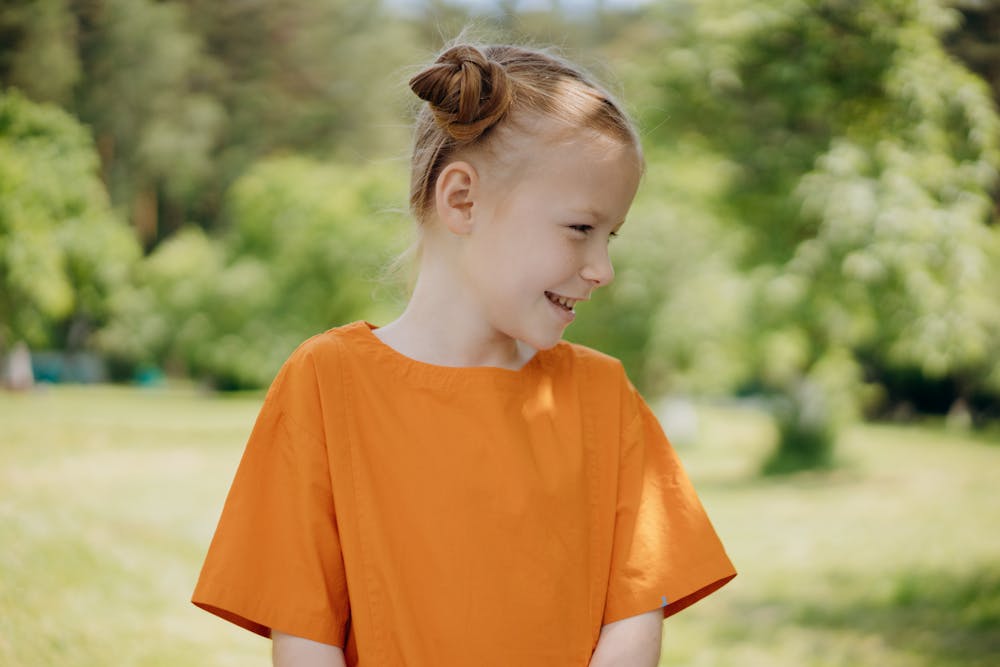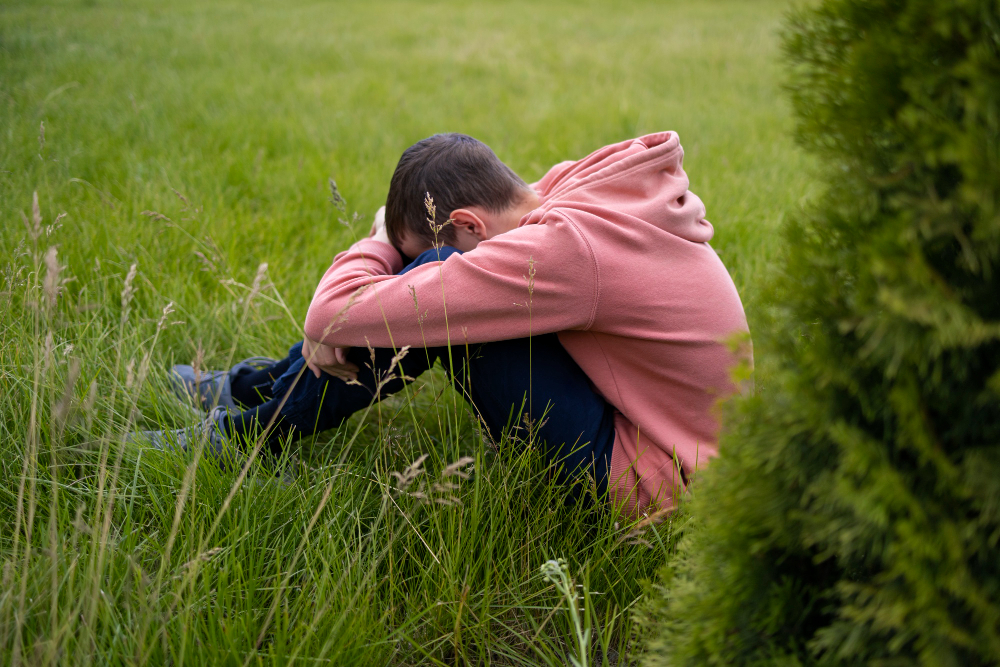I was folding laundry late one night, brain running on the kind of background grief that rarely quiets, when my hand closed around the orange shirt. I moved to set it aside—automatically, instinctively—because I remembered September was coming, school would be starting, and Orange Shirt Day would follow quickly after. That shirt would be needed soon, and in the chaos of a mid-September move, I wanted to know where it was. But then I paused, heart half-sinking, because I remembered: that shirt belongs to my son. And it is unlikely he will return to school at all.
He has been in bed since March, suffering a complete nervous system collapse. Months of humiliation, coercion, and the relentless erosion of support wore him down. Every IEP promise broken, every goal turned into a demand, every act of dysregulation treated as a personal indictment or ignored.
And now, when I look ahead, I do not see a path back to school for him. I see instead an Orange Shirt folded gently into a memory drawer, a symbol of both what we mourn and what we refuse.
Orange Shirt Day and the failure to guarantee safety
Indigenous families were once criminalised for resisting school attendance, punished collectively through state violence, and are now invited—often pressured—to return their children to those same institutions without any structural guarantee that harm will not be repeated.
And while banners hang and t-shirts sell out, schools still impose punishments on vulnerable children, retraumatising those already made wary by history. The logic of collective punishment did not dissolve with the closure of residential schools—it simply adapted.
It was renamed as positive behaviour management, reframed as classroom strategy, sanitised through colour-coded charts and token economies and smiles.
Today, when a child’s distress results in cancelled privileges for a group, the school replicates the same belief that justice means loss, and loss must be shared. We tell ourselves that we are teaching accountability—but what we are teaching is fear of difference, surveillance of peers, and the inevitability of harm.
This is not the same violence that residential school survivors endured—there is no equivalence in scale or intent—but the symbolic resonance is difficult to ignore, and the scapegoating of disabled, neurodivergent, and racialised children is still deeply consequential.
Collective punishment no longer looks like a strap across the palms—it looks like a child exiled from recess under the weight of her classmates’ glares, a field trip cancelled because someone cried too loudly, an orange shirt draped over a child told they matter while their IEP lies unread in a drawer, a child welcomed into the circle only so long as they do not cost too much, ask too much, or feel too much.

Collective guilt as a justification for institutional violence
In his critique of Collective Guilt and Collective Punishment, Fletcher explores how state actors justify punishing innocent individuals by collapsing guilt into membership. The logic is brutally simple: if someone from your group causes harm, your group must suffer. This premise has been used across history to rationalise violence and maintain institutional power because it deters defiance.
Fletcher examines some of the most extreme articulations of its collective punishment logic—namely, proposals by Alan Dershowitz and Nathan Lewin that sought to justify retaliatory violence against entire Palestinian villages and families.
“Under the pressure of the second Intifada beginning in September 2000, many otherwise sober and rational American Jews lost their sense of proportion and began advocating collective punishment for Palestinians. On the assumption that it takes an entire village to create a suicide bomber, Alan Dershowitz started proposing various ways of penalizing the entire village – including destruction of all the houses in the area.” Collective Guilt and Collective Punishment
This argument, morally bankrupt and strategically chilling, shows how quickly guilt can be assigned by association, and how swiftly innocence is erased when a group is deemed dangerous.
Though the context differs, the same pattern—convenient, cruel, and collective—can be found in BC schools. A child has a meltdown; the class loses their field trip. A student fails to comply with a behavioural chart; the classroom economy collapses. The innocent are swept into the sanctions of the few, and every child learns to resent the one who could not behave.
Residential schools ran on this logic
And as Chiara Serioli observes in Cultural Genocide of Indigenous Peoples in Canada, the system was not only designed to dismantle Indigenous identity—it was sustained through ritualised violence, surveillance, and coercive conformity.
As Serioli summarises, the system deprived children of their language and culture, subjected them to repeated abuse, and punished them harshly for resisting the forced process of assimilation she writes, showing how punishment itself was both method and message.
When one child ran, many were punished. When one spoke their language, others were beaten too. The school did not see children as individuals—it saw threat in kinship, and so it punished the group to sever belonging. These were not anomalies; they were systemic.
Fletcher’s work explains how collective punishment becomes justified when the perpetrator is erased from view and the group is held responsible—where suffering is repackaged as deserved, where deterrence disguises cruelty, and the institution denies its own role by saying, in effect, the institution denies its own role and reassigns blame to the group itself—portraying suffering as deserved, and responsibility as something the victims created by their own presence and resistance.
Between the strap and the sticker chart: collective punishment light
In a recent piece titled What replaced the strap in Canadian schools?, I explored how the logic of discipline—though altered in form—remains intact. The strap was folded into history, but the idea that children must be subdued, controlled, and made examples of never left the room. It simply changed costume.
Collective punishment in Canadian schools did not end when corporal punishment was banned—it evolved. What replaced the strap was: token economies, behaviour charts, reward-loss systems, and peer surveillance. The language softened, but the lesson remained the same: the collective will be punished to deter disobedience.
Here is a quote from the testimony of a residential school survivor from Sandy Bay School:
“I had to learn the hard way to communicate in school what the, the nuns or the teachers wanted. And if you didn’t, if you didn’t understand that, it was you were being punished, sometimes physically, and then sometimes emotionally. Like you were made fun of sometimes by other people in your class, like if I said, or did something wrong everybody would laugh at you.”
—Robert Malcolm
The cruelty of that dynamic remains unresolved. In contemporary classrooms, children who misunderstand a question, struggle with expressive language, or interpret things literally are still laughed at. The medium may shift—from spoken taunts to digital chats or silence edged with sarcasm—but the humiliation functions the same. This is the emotional infrastructure that sustains collective punishment: a culture in which vulnerability is policed by shame and conformity is enforced by peers, where some children are scapegoated.
That act of forced compliance—of bending one’s voice to survive—was both punishment and pedagogy, a violent lesson in erasure. And while the form of punishment has changed, the demand for emotional submission and the spectacle of humiliation remain intact. The cruelty is now crowd-sourced; the child who says or does the wrong thing is still made into a warning, only now the laughter comes from peers, the judgment from a sticker chart, the consequence dressed as feedback.
Contemporary schools still collapse guilt and punishment
Today, the pattern continues with different language. An Indigenous child is blamed for “disrupting” the class, and the whole class is punished. A sensory room is locked, then a student’s regulated presence in that room is cited as the reason the field trip cannot proceed.
Fletcher questions how far the idea of complicity can be stretched to include those who take no active steps, warning against frameworks that assign guilt by proximity or identity.
And yet in BC schools, this very logic is applied daily. The vulnerable are punished through association—blamed not for what they have done, but for who they are, how they move, how they struggle.
Collective guilt becomes the pretext; institutional convenience becomes the method.
As Dillbary and Miceli argue in Of Sinners and Scapegoats: The Economics of Collective Punishment, this logic is not incidental—it is economically expedient. When institutions cannot afford to meet individual needs, they outsource discipline through symbolic gestures and broad sanctions that preserve the appearance of control.
In public education, this means punishing the group to deter the individual, because it costs less than actually supporting that child.
It means placing the burden of regulation on the collective—teachers who manage without aides, students who suppress their emotions, and parents who perform shadow labour—while the system shields itself from accountability.
Rather than address trauma, unmet needs, or systemic gaps, schools distribute consequences broadly and swiftly—cancelling events, revoking privileges, or threatening group rewards. These tactics are fast, legible, and cheap. They do not require policy change or staff hiring. They only require a scapegoat.
-
The compliance economy
In their article Of Sinners and Scapegoats: The Economics of Collective Punishment, J. Shahar Dillbary and Thomas J. Miceli argue that collective punishment emerges not merely as a failure of precision or fairness, but as a deliberate mechanism for preserving internal group cohesion. The…
The trauma of collective guilt in families
When schools suggest that one child’s distress endangers others, and punishment is framed as necessary to ‘restore safety,’ families are conscripted into that logic—forced to accept a narrative in which their child becomes the threat.
This framing is especially galling given the public rhetoric of inclusion and reconciliation, where schools wear orange shirts and recite land acknowledgements, even as they punish the most vulnerable children for behaviours rooted in unmet needs. It is a hypocrisy so entrenched that it disguises harm as order, and positions collective punishment as care. It becomes emotionally impossible for a parent to protect their child without appearing to endanger others.
I imagine this hypocrisy lands with particular force on Indigenous parents, who are invited into the rituals of reconciliation while simultaneously expected to tolerate many of the same coercive mechanisms their families have endured for generations. The violence may be rebranded, but its social function remains—to isolate the “problem,” to preserve the institution, and to treat care as a liability when it challenges control.
-
Punished for bed wetting
I’ve woken up in the middle of the night to help my children when they’ve wet the bed—perhaps after a bad dream or too much water before bedtime. I remember helping them change their clothes, stripping the bed, telling them gently: it’s okay.…
Refusal, safety, and the meaning of reconciliation
For Orange Shirt Day to mean anything, schools must stop punishing children for each other’s distress. Indigenous children must be guaranteed freedom from retaliatory discipline—freedom from being cast as the reason others suffer.
Fletcher reminds us that it is possible to confess, to remember, to repair, without seeking a scapegoat.
In schools, this means we can honour the pain of the past without repeating the patterns that caused it. We can teach about injustice without reproducing it. We can centre memory without enacting discipline on children who are already struggling. Instead of punishing a class because one child melts down, we can ask what that child needs. Instead of removing privileges to preserve order, we can build environments where no one needs to scream to be heard. This is not just a moral idea—it is a direct challenge to how schools currently operate. Right now, schools ask children to remember the trauma of the past while continuing to create trauma in the present. They hang banners about reconciliation and invite students to wear orange shirts, but then use blanket consequences that isolate and shame children for being different, disabled, dysregulated, or slow to comply.
A child who cannot meet expectations is treated as a threat to group safety, and the group is punished to keep the lesson sharp. This is not education—it is ritualised control masquerading as care. If we truly believe in reconciliation, we cannot perform grief for the past while authoring harm in the present. It is entirely possible to teach children about injustice without inflicting new forms of it. It is entirely possible to hold guilt without producing a new scapegoat. And it is essential that we do so—because otherwise, we are rehearsing betrayal in the name of remembrance.
Serioli notes that the Canadian state still has not taken full responsibility for the systemic nature of the violence inflicted. Nor has it guaranteed that this violence will not continue in new forms. For reconciliation to hold meaning, there must be not only truth, but change—not only ceremony, but cessation—not only acknowledgment, but assurance. And that assurance must begin with the end of all collective punishment in public schools. We need structures that respond to harm with support, not sacrifice. We need policies that protect difference, not demand its erasure.









